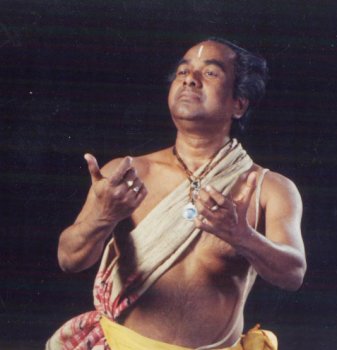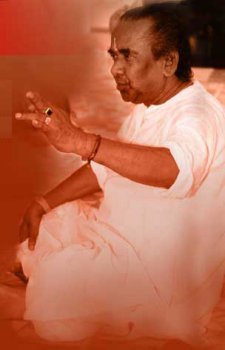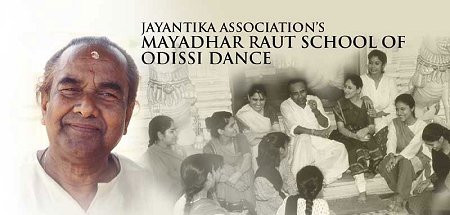
|   |

|   |
Guru Mayadhar Raut - Ashish Mohan Khokar, Bangalore e-mail: khokar1960@gmail.com Based on archival materials from The Mohan Khokar Dance Collection July 30, 2010 July 6th celebrated the birth of the youngest of four pillars of Orissi, Mayadhar Raut. The youngest of the four Orissi gurus, Mayadhar Raut, having just stepped into his eighties, was born in the village of Kantapenhara in Cuttack district. Here, there was a Krishna Leela party. Krishna Leela differs from Ras Leela in that while in the latter the performers are only boys up to the age of 14, in Krishna Leela adult characters are portrayed by adults. Mayadhar's grandfather was connected with the troupe, occasionally helping it financially or doing bit roles, and Mayadhar's elder brother Harihar Raut used to play the part of the child Krishna. Mayadhar's father was a cultivator. Adjacent to his fields were those of Kali Charan Patnaik of Cuttack, who then ran a drama troupe known as Sakshi Gopal Natya Sangh, named after Sakshi Gopal, the first play he had written. He once came on a visit to the village and saw Mayadhar. Impressed with his looks and demeanour, he asked the father if the boy knew any singing. Mayadhar rendered a song that he had learnt in school. It was enough. Kali Charan asked the father if he might take the boy with him, and the father agreed. So at the age of seven, Mayadhar found himself in the theatre. Kali Charan's Sakshi Gopal Natya Sangh was on the verge of being wound up and his Orissa Theatres was beginning to take shape. Simultaneously, he maintained a Ras Leela party that had been in existence even before he had started the Sakshi Gopal Natya Sangh. Young Mayadhar was given the role of Krishna in the Ras Leela plays. There was no payment, only food. Mayadhar, as also the other boys, had to put their hands to anything, such as pressing the limbs of the senior performers, bringing water for their bath and fanning them. Every morning and evening, they had to sing together a song from the Geet Govinda, that was almost like a ritual. They had to get up at 4 in the morning for voice training. This was followed at 6 by dance practice and rehearsals of plays at 9. Eventually the Ras Leela party of Kali Charan was dissolved and most of the artistes were absorbed in his Orissa Theatres. Mayadhar too found himself in the new group. He got greater prominence as a dancer, and that was all. But he was now paid a salary of Rs. 2 per month, whereas earlier he received nothing. Dancing in plays was taken more seriously. In Kali Charan's play Jaideva, for instance, veterans Mohan Mahapatra and Singari Shyam Sundar Kar were invited to compose a mahari dance, which was part of the theme. The dance was performed by two girls and it was the first time that the dance of the maharis came to be presented on a professional stage. Again, in the play on Chaitanya's visit to Orissa written by Chaitanya's contemporary Jagannatha Dasa, a Gotipua sequence was required. This again was composed by the same two gurus. The role of gotipuas was taken by Mayadhar Raut and another boy, Gopinath Behera. It was the first time that the Gotipua dance was performed on professional stage. Several other dances too came to be composed, to embellish dramas, more often than not without sufficient reason. Durlabh Chandra Singh, Harihar Raut and Kartik Kumar Ghosh were the composers of these numbers which were given names such as Shiva Puja, Madana Bhasma, Kumara Purnima, Junglee Nritya and Paik Nritya.   Mayadhar was afraid to return to Cuttack; he feared he would not be welcome at his village either. He got out at a wayside station Balanga, and from there went to Banapur, where he knew there was what was known as the Bhagavati theatre. Perhaps he might get a chance there. He was accepted, on a salary of Rs. 10 per month, a big jump from the Rs. 2 he earned in Kali Charan's Orissa Theatres. In the meanwhile, however, on Kali Charan's report, the police were on Mayadhar's tracks. Presently he was caught, taken to Cuttack and put into prison. When he told his whole story, however, he won sympathy and was released. He returned to his village, but felt completely out of place there. Restless, he went again to Banapur but thanks to a devastating cyclone, the Bhagavati Theatre had suffered enormous loss and had collapsed. In this situation, the only saviour Mayadhar could think of was Annapurna, at that time the most vigorous theatre in Orissa. It now incorporated dance as embellishment in practically all its plays. This applied to both the 'A' group in Puri and the 'B' group in Cuttack. Mayadhar had a weakness for Cuttack; he felt more at home there. But Bauri Bandhu Mohanty, the key figure behind 'A', persuaded him to stay on in Puri for, having parted with the rest, he was planning to launch yet another splinter group; that came to be known as Annapurna 'C'. This Mayadhar joined. Mohan Sundar Devagoswami was director of dance and his son, Gaur Sundar Goswami, director of plays. Mayadhar was happy, for he had the opportunity to dance, which by then had become his first love. In two of the earliest plays presented by the group, Mana Bhanjan and Jagannath Vallabh, Mayadhar was cast as Radha. Unfortunately, 'C' group wound up within a few months, and Mayadhar again found himself without work. He went to Cuttack, where in spite of his past unflattering record and thanks to his brother Harihar Raut, he was accommodated in Annapurna. Pankaj Charan Das and Kelucharan Mahapatra were also there. In 1955, Mayadhar was awarded a scholarship by Utkal Nritya Sangeet Natyakala Parishad for training in Kathakali with Bharatanatyam as subsidiary at Kalakshetra in Madras (Chennai). Apart from what he personally gained, indirectly this made a lasting impact on Orissi. It is to be conceded that practitioners of Orissi until that time, including gurus, maharis and gotipuas in the using of hastas or hand gestures in dance, were depending solely on habit and had no knowledge of their nomenclature or the viniyogas, multiple interpretations of each. Mayadhar Raut's exposure at Kalakshetra and return to Cuttack was to radically alter the position. At Kala Vikash Kendra, he became instrumental in completely changing to the approach of the hastas in Orissi. The same happened in the case of Sanchari bhava or the elaboration of an idea or theme through closely related motifs. At the time that Mayadhar Raut was in Kalakshetra, a ten year old girl from Cuttack, Sanjukta Mishra, was already there, pursuing Bharatanatyam on a scholarship. After her return to Cuttack, the reforms initiated by Mayadhar Raut received further stimulus. The practice of wearing knee-length sari in the classroom for Bharatanatyam came to be adopted in Orissi because of Sanjukta Mishra. The first to benefit from the innovations stated above was Kala Vikash Kendra. It is not that Mayadhar Raut or Sanjukta Mishra joined as teachers, but they voluntarily and willingly made themselves available to the Kendra for their contributions. Though Jayantika had been constituted in 1957, it was only two years later that it started gaining ground. This was when Mayadhar and Sanjukta returned from Madras (Chennai). Their presence at the meetings sort of galvanized the deliberations. Eventually came the day when all heaved a sigh of relief. A system of codification of the technique of Orissi and the structured format of its repertoire had been drafted. The flush of success enthused the participating gurus - Kelucharan Mahapatra, Deba Prasad Das, Mayadhar Raut, Raghunath Datta and Dayanidhi Das - to draw up a manifesto spelling out their decisions and resolutions, to which each of them put his signature in his own blood. The one copy of this rare document exists in the MKDC (Mohan Khokar Dance Collection).  In the years that followed, several other ballets were put up but then, suddenly began the decline of Nritya Niketan. When it was at its peak, one by one, the gurus and teachers started quitting. This was when they realized that the administration was far from clean and over the years they had been substantially fleeced. Innocently they had been signing receipts for payments far more than they were being given. It is at this time that Mayadhar Raut joined Shriram Bharatiya Kala Kendra as the Orissi guru. The Oriya community in Delhi had long been eager to have a religious centre cum cultural pocket of theirs, and this began to take shape from 1969. The foundation stone for a temple of Jagannath, under the management of a new voluntary body Sri Neelachala Seva Sangha, was laid. The driving force behind this was one of the secretaries of the Sangha, Kshirod Mohanti. As soon as the temple complex was ready, classes in Orissi were introduced with Mayadhar Raut as guru and Aloka Panikar to assist him. There were many students, not only Oriya but others as well. Having just entered the 8th decade of his life, Mayadhar Raut is now retired but still lives in Delhi. While he was at the SBKK, he trained not only Indian students but also those who came on ICCR scholarships. There is a long list of dancers he trained in Delhi- starting from Aloka Paniker to Kiran Segal, Ranjana Gauhar, Rajshri Gupta, Usha Gupta, Gita Mahalik among others. Of those who came from countries abroad were Chandravati Sukhai, Vidyotama Sharma, Martha. Some of his Indian students have moved abroad and are running Orissi schools in his name, his daughter Madhumita is now trying to outreach his work..his work lives on! (Extracted from Mohan & Ashish Khokar's forthcoming book The Dance Orissi by Abhinav, app 400 photos in 350 pages)  As successor and inheritor of Mohan Khokar's work, Ashish continues to serve dance. Thanks to the wealth of materials left, he has been able to do 35 books and edit-publish 'attendance,' India's only yearbook on dance and its history. He also served the Sahitya Kala Parishad; Festivals of India in France, Sweden, Germany and China and Martand Singh Consultants before becoming a full-time dance writer serving the Times of India as their dance critic for two decades and many magazines and journals, including narthaki. attendance-india.com |